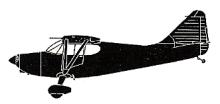
ASN Wikibase Occurrence # 296988
This information is added by users of ASN. Neither ASN nor the Flight Safety Foundation are responsible for the completeness or correctness of this information.
If you feel this information is incomplete or incorrect, you can submit corrected information.
| Date: | Wednesday 10 July 2002 |
| Time: | 10:25 LT |
| Type: |  Stinson 108-2 |
| Owner/operator: | Private |
| Registration: | N390C |
| MSN: | 108-3390 |
| Total airframe hrs: | 748 hours |
| Engine model: | Franklin 6A4-165 |
| Fatalities: | Fatalities: 0 / Occupants: 1 |
| Aircraft damage: | Substantial |
| Category: | Accident |
| Location: | Lincoln Park, New Jersey -
 United States of America United States of America
|
| Phase: | Unknown |
| Nature: | Private |
| Departure airport: | Lincoln Park, NJ (N07) |
| Warwick, NY (N72) | |
| Investigating agency: | NTSB |
| Confidence Rating: |
The pilot conducted a preflight inspection, started the engine, and performed magneto and carburetor heat checks. He then taxied the airplane about 1,500 feet for takeoff, and had to wait, with the engine at idle, while four other airplanes landed, and the one in front of him took off. Prior to takeoff, the pilot selected takeoff flaps and takeoff trim. During the takeoff roll, the pilot felt the airplane was not accelerating normally, but attributed it to summer temperatures. About 1,000 feet down the runway, the airplane broke ground briefly, then settled back down and became airborne again in about 100 feet. After the pilot subsequently "got it off the ground," he felt that it was not accelerating normally, so he pushed the yoke forward and raised the flaps. The airplane drifted off the left side of the runway and settled into a parked airplane before continuing up an embankment, and coming to rest partially on a road. In a statement provided several months after the accident, the pilot stated that the engine "was not running" when it settled into the parked airplane. Post-accident examination of the airplane revealed no mechanical discrepancies which could have contributed to the accident. The fuel was checked, and found to be clear, blue in color, and absent of debris. A carburetor icing probability chart revealed that ambient conditions during the time of the accident could have resulted in moderate icing at cruise power or serious icing at glide power. According to a maintenance technician, the engine was susceptible to carburetor icing on the ground due to the position of the air intake manifold. After a ground run-up subsequent to the accident, the carburetor box was cold to the touch.
Probable Cause: The pilot's failure to abort the takeoff when diminished performance was noted. A factor was carburetor icing, accumulated before the takeoff attempt.
Accident investigation:
 |
|
Sources:
NTSB NYC02LA136
Revision history:
| Date/time | Contributor | Updates |
|---|---|---|
| 14-Oct-2022 13:10 | ASN Update Bot | Added |
Corrections or additions? ... Edit this accident description
The Aviation Safety Network is an exclusive service provided by:


 ©2024 Flight Safety Foundation
©2024 Flight Safety Foundation